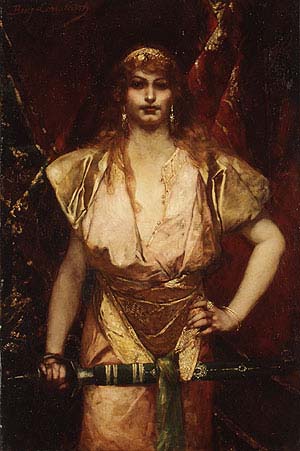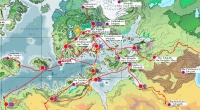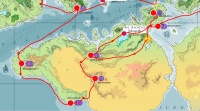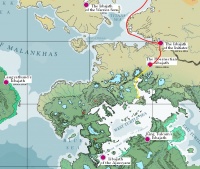The Isbajutha
Also known as the Psychic Crusades, the Isbajutha (plural, from Khahonri 'sebejeh,' to fight against with intention; singular isbajath), are the series of calculated wars that brought to an end the dominions of the great Chaos Rulers of the Middle Ages. The Isbajutha consist of the general psychic crusades demanded by the then-ruling Incarnandina and the lesser psychic crusades, each general Isbajath (psychic crusade) being designated with a number and each lesser isbajath designated with a non-numeric name.
Numerous other conflicts arose during the Isbajutha as the worship of chaos and the practice of chaos magic had become firmly entrenched throughout the Pallathantic Region. The Shenimite Incarnandists, their converts, and their allies in the Arathracian Church followed an organized program aimed at eliminating the chaos leaders with immense success.
The extirpation and exile of the most egregious leaders of the chaos movement fell even more swiftly on the Pallathantic than the speed with which chaos cults arose and flourished in the Middle Ages. Practitioners, priests, and cultist of chaos not slain or converted through the Isbajutha fled into hiding, sometimes with great irony, concealing themselves and their works in the very places of refuge where they had driven Incarnandists and others during the former rule of the princes of chaos.
General Isbajath
Only the acting Incarnandina could invoke the call for a general isbajath. Each such psychic crusade was numbered in chronological order. Incarnandist warriors were spiritually obligated to heed her summons and offer whatever powers that God had granted them in the service of the isbajath. The Incarnandina appointed the generals, often members of her own family, based on the council of retinue who consisted of powerful Incarnandist energists (psychics) often with the abilities of seership in the past, present, and sometimes future. The faithful who fell in the course of an isbajath were thought to enter into the presence of God and become companions of the energy of the Incarnandus. Each general isbajath was also associated with a specific zodiacal sign.
Chronological List of The Isbajutha
Sources
 Primary Sources
Primary Sources
- Address of Zihera kath Z’alulah to warriors of the Seventh Isbajath, 23rd Century
- Archomagus Codex, 23rd Century
- Asbard Bestiary of Throes
- Asbard Book of Manic Devotions, 20th Century
- Basiliary Codex, very early 24th Century
- Funeral Oration of Tirkha kab Ath’on kab Haliyk, ca 2300
- The Glamsagin Chronicle, ca 2290, Ra'esel kab Naphug
- Legend of Saint Gidhoniel, ca 2400s, Gasraf kab Eth'eb
- Lygdamioniac Invocation, Late 23rd Century
- Oath of the Shenimite Warrior, ca 2240
- Prayers of St. Ithraig dhal Fascaghire, 23rd to 24th century
- Sanctuarial Register of Sruha Leham, 23rd Century
 Secondary Sources
Secondary Sources
- Azbulihan's Guide to Djinn of Weshif, Azbulihan ikib Asulimaana, 2421
- Foundations of the Oliblishi Kingdom, Wanwaya kath Safya, 2527
- From the Fifth Isbajath to the Fifth Geddamin War: The Transformation of Early Modern Aurice, Danax Aistaga, 2702
- God's Whirlwind: The Isbajutha, Thulinantis Tepriax of Zamaclë, 2568
- Jerushabla and the Isbajutha, Wanwaya kath Safya, 2519
- Our Heritage of Incarnandist Saints, Rhionantis the Younger of Aurice, 2619
- Siege of Bryndyd (Book), Straudh dhal Rhiggoinech Siarbha, 2619
- Sword of the Maiden of Zephas, Irchoram of Asberdon, 2547, Sometimes treated as a primary source
- The Witch and the Tisbajiya: The Second Battle of the Archmage, Aiachourn dhal Caspain Sichogha, 2687
See Also
- List of Greater Chaos Rulers of the Middle Ages
- List of Lesser Chaos Rulers of the Middle Ages
- Chronology of the Isbajutha
| This article is a stub. It requires further development by the creator. |



